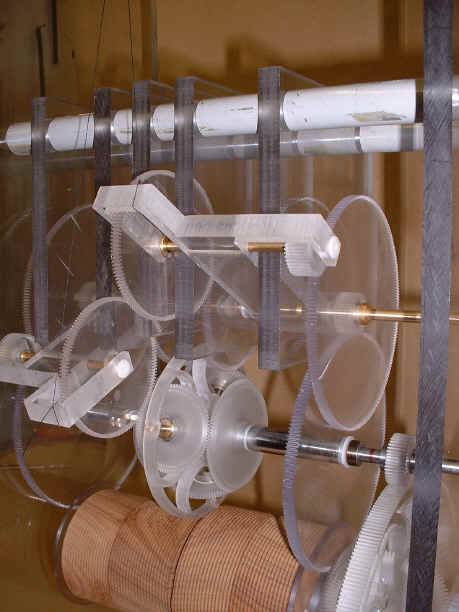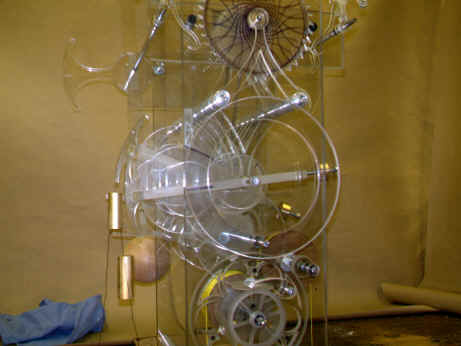These working models show the development of the heart of the clock - the escapement, remontoire, pendulum balances and the basics of the going train. It's important to note that while we borrowed liberally from Harrison's H1 design for our pendulum balances and grasshopper escapement, we went several steps further. Harrison's escapement operated on one wheel ours doubled it to two counter-rotating escape wheels; each driven by it's own pendulum and remontoire connected through a differential system. The type of remontoire we used is Wagner's swinging-frame concept, again never before used in a tandem design. The inspiration for the double remontoire was a tower clock by Cooke & Sons in the Royal palace Courts of Justice, England. However, that remontoire is mediated by a cam, not a differential and is not a true swinging frame design. I also chose to double Harrison's one second 'tick' to two, giving a slower, more hypnotic pendulum effect. This also had the fortuitous advantage of helping our movement conserve the drop necessary for an eight day duration. The idea is to maximize the visual effect of the counter-rotating escape wheels. A design drawing is here. The multiple cocks needed to support the remontoire was eventually cut in half.
These are the first videos taken by the Buchanan firm in April 2006. They document the design and creation of the basic elements of the going train for the astronomical skeleton clock. The main components are: Dual compound pendulums, splitting differential to alternately power a pair of Wagner gravity remontoire. These, in turn drive a pair of counter-rotating grasshopper escapements. Notice how the bird-design was envisioned for the escapements right from the beginning. Other components are drive gearing from the weight barrel. Escapement: The counter-rotating escape wheels will have the spokes cut so as to provide a kaleidoscope effect. In this shot the spokes are painted on a clear plastic toothed disk in black. The system has not yet been adjusted to get the spokes to precess. The escapement pallets have graceful curvilinear parts and are designed to maximize movement and visual impact. These will be jeweled in the manufactured version. Movement overview: Notice that the pendulum balances have a cycle of 4 seconds versus the more common 2 second cycle as was used in Harrison's H1 and most of all the later versions based on this design. I think that the slower rate is more hypnotic and not quite so distracting as the faster cycle. A fortuitous side effect is the fact that the entire train runs twice as slow reducing wear and, most importantly, alleviating the critical issue of sufficient drop for an eight day duration. Here the escapement spokes do precess. Remontoire differential: One can see the differential at the center of the picture move slightly as the remontoire cage is raised and lowered. This differential powers both remontoire sequentially, as each drives it's individual escape wheel which, in turn, are mediated by their individual pendulum balance. The system stays in synch because the balances themselves, as in the H1, are slaved together. Dual Wagner swinging frame remontoire: Each
alternatively rises and lowers and this is accomplished through the
remontoire differential above. The idea was inspired by a tower clock
serviced by Buchanan and later seen by me when I visited him before his move
from England in 2005. It was located at the Royal Courts of Justice, it was
a Dennison gravity escapement made by Gillett and Johnston and also equipped
with a dual remontoire based partially on Wagner's design.
|





